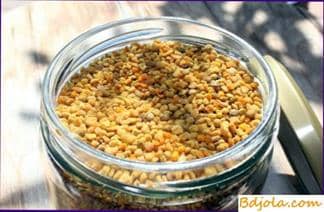
Pollen in the form of grains is indigestible, since human gastric juice can not destroy the outer membrane (film) – the ectium, which surrounds each grain. The components of the pollen grains can be extracted only through the smallest holes of the ecthim, if you grind pollen grains in the smallest powder, or insist pollen in distilled water for at least two hours, periodically shaking. Then the solution is filtered, ascorbic acid is added and drunk 1 1 / 2-2 hours before meals.
Flower pollen – a good biological stimulant, acting on a decrepit aging body. Bulgarian scientists (observations of 23 elderly people in the clinical department of the Bulgarian nursing home) noted the positive effects of pollen, royal jelly and honey on the physical and mental state of the elderly.
Pollen of plants can serve as an excellent source of obtaining large amounts of carotene. In the pollen of the lily and the yellow acacia, it is 20 times larger than in the red carrot, and she is the main producer of this vitamin. The expediency of obtaining carotene from pollen of lily, yellow acacia and other plants is also due to the simplicity of its extraction by direct extraction of provitamin A from the pollen grains without any preliminary treatment.
Approximate calculations show that from 100 lily plants it is possible to collect up to 10 g of pollen and obtain from it up to 25 mg of the carotene preparation, and from a hectare up to 30 kg of pollen containing about 100 g of carotene.
Flower pollen is exceptionally rich in routine (vitamin P), which is called the vitamin of youth. In the pollen of some plants, in particular buckwheat sowing, it contains up to 17 mg%. Therefore, pollen should attract the attention of researchers with regard to further study of its chemical composition and biological effect.
Сухари в меде. Обработка пчел муравьиной кислотой весной.
Pollen and Perga